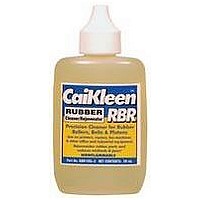RBR100L-2 CAIG LABORATORIES, RBR100L-2 Datasheet - Page 3

RBR100L-2
Manufacturer Part Number
RBR100L-2
Description
RUBBER CLEANER, BOTTLE, 59ML
Manufacturer
CAIG LABORATORIES
Series
CaiKleen RBRr
Datasheet
1.RBR100L-2.pdf
(7 pages)
Specifications of RBR100L-2
Cleaner Applications
Office Equipment, Machinery, Rubber Rollers & Platens
Dispensing Method
Bottle
Volume
59ml
Lead Free Status / RoHS Status
Lead free / RoHS Compliant
Prepared to OSHA, ACC, ANSI, WHMIS & 2001/58 EC Standards
6.1
7.1
7.2
7.3
8.1
8.2
8.3
8.4
8.5
Spills:
Secure spill area, remove or minimize all sources of ignition, and maximize ventilation. Stop spill or leak at source if safely possible.
Deny entry to all unprotected individuals. Individuals involved in the cleanup must wear appropriate personal protective equipment.
Recover free liquid or cover with inert absorbent material and place into appropriate container(s) for disposal. For small spills, absorb or
cover with dry earth, sand, or other inert non-combustible absorbent material and place into waste containers for later disposal.
Contain large spills to maximize product recovery or disposal. If necessary, dike well ahead of the spill to prevent runoff into drains,
sewers or any natural waterway or drinking supply. Contact appropriate local and/or provincial authorities for assistance and/or
reporting requirements. For water spills, remove from surface by skimming or with suitable absorbents. If allowed by federal & provincial
environmental agencies, sinking and/or suitable dispersants may be used in unconfined waters. Consult an expert on disposal of
recovered material. Ensure disposal on compliance with government requirements & secure conformity to local disposal regulations.
Notify the appropriate federal & provincial authorities immediately. Take all additional action necessary to prevent & remedy the
adverse effects of the spill.
Work & Hygiene Practices:
Wash hands thoroughly after using this product and before eating, drinking, or smoking. Remove soiled clothing to prevent prolonged
skin contact. Avoid breathing vapors. Avoid direct skin contact.
Storage & Handling:
Use and store in a cool, dry, well-ventilated area. Keep away from excessive heat, open flames, sparks, and other possible sources of
ignition. Do not store in unmarked containers or storage devices
Special Precautions:
Empty containers may contain product residues.
containers without commercial cleaning or reconditioning.
Ventilation & Engineering Controls:
The use of mechanical dilution ventilation is recommended to maintain airborne concentrations below the recommended
occupational exposure limits, whenever this material is used in a confined space, is heated above normal temperatures (up to 38ºC) or
is agitated.
Respiratory Protection:
Vaporization or misting is not expected at ambient temperatures. Therefore, the need for respiratory protection is not anticipated under
normal use conditions and with adequate ventilation. If elevated airborne concentrations above applicable workplace exposure levels
are anticipated, a NIOSH-approved organic vapor respirator equipped with a dust/mist prefilter should be used. Protection factors vary
depending upon the type of respirator used. Respirators should be used in accordance with OSHA requirements (29 CFR 1910.134).
Eye Protection:
Safety glasses equipped with side shields should be adequate protection under most conditions of use. Wear goggles and/or face
shield if splashing or spraying is anticipated. Wear goggles and face shield if material is heated above 125 °F (51 °C). Have suitable eye
wash water available.
Hand Protection:
Use gloves constructed of chemical resistant materials such as neoprene or heavy nitrile rubber if frequent or prolonged contact is
expected. Use heat-protective gloves when handling product at elevated temperatures.
Body Protection:
Avoid prolonged and/or repeated skin contact. Use clean and impervious protective clothing (e.g., neoprene or Tyvek®) if splashing or
spraying conditions are present. Protective clothing should include long-sleeves, apron, boots and additional facial protection.
Remove oil contaminated clothing. Launder oil contaminated clothing before reusing. Contaminated leather goods should be
removed promptly and discarded.
MATERIAL SAFETY DATA SHEET
8. EXPOSURE CONTROLS & PERSONAL PROTECTION
7. HANDLING & STORAGE INFORMATION
6. ACCIDENTAL RELEASE MEASURES
Do not pressurize, cut, heat or weld empty containers.
MSDS Revision: 1.0
MSDS Revision Date: 01/01/2007
Page 3 of 7
MSDS-E-RBR100L
Do not reuse empty






